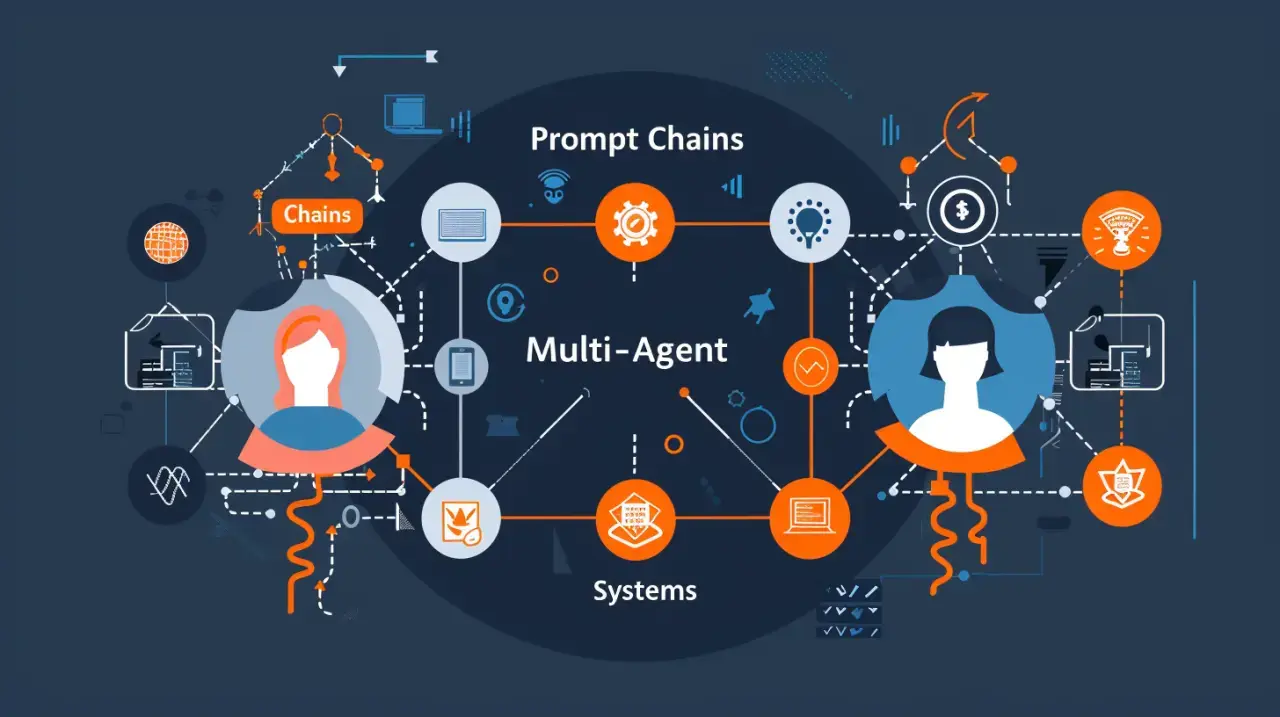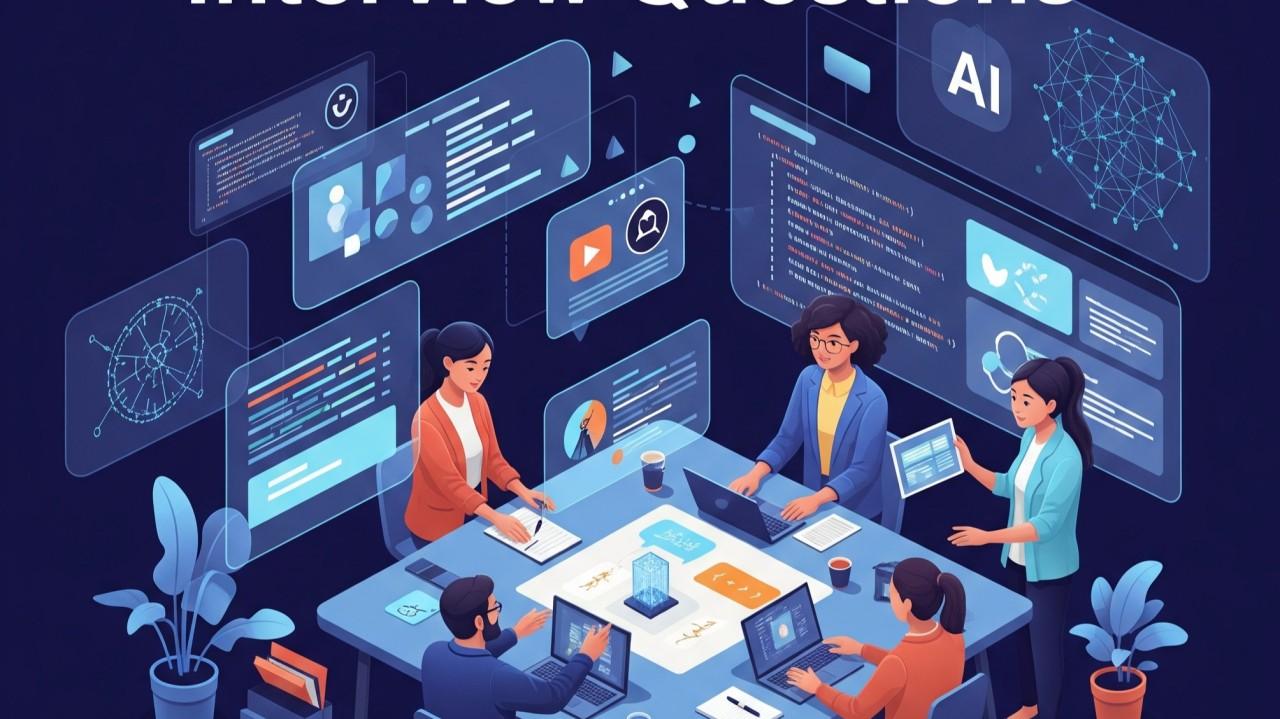Section 1: Introduction
For decades, interview preparation has evolved alongside technology. In the early 2000s, candidates relied heavily on books like Cracking the Coding Interview to memorize algorithms and solve whiteboard problems. By the 2010s, platforms such as LeetCode, HackerRank, and Interview Query revolutionized the space, offering interactive practice and global competition. And in the early 2020s, mock interviews with peers, coaches, or prep platforms became the gold standard for gaining confidence.
But as we enter 2025, a new paradigm is emerging: AI-powered mock interviews. These tools are no longer simple question banks with multiple-choice grading. Instead, they simulate realistic technical and behavioral interviews, provide structured feedback, and adapt to each candidate’s skill level in real time. For ML engineers in particular, this evolution is a game-changer.
Why ML Interviews Are Especially Challenging
Machine learning interviews are fundamentally different from standard software engineering interviews. Instead of focusing only on coding, they span multiple dimensions:
- Core ML knowledge: Algorithms, probability, statistics, optimization.
- System design: Large-scale ML infrastructure, data pipelines, and distributed training.
- Behavioral: Collaboration, ambiguity management, stakeholder communication.
- MLOps: Deployment, monitoring, and retraining pipelines.
This combination means that ML engineers must prepare for varied and often unpredictable interview rounds. A candidate might face back-to-back sessions covering ML coding, product-focused ML design, and behavioral storytelling. Traditional prep methods struggle to replicate this diversity.
As noted in Interview Node’s guide “ML Interview Tips for Mid-Level and Senior-Level Roles at FAANG Companies”, candidates often fail not because of technical weakness but because they cannot practice end-to-end interview scenarios. That’s where AI-powered mock interviews step in.
Why AI Is Entering the Scene
Advancements in large language models (LLMs) have created the possibility of realistic interview simulations. Imagine an AI interviewer that:
- Asks you a system design question, challenges your assumptions, and adapts based on your responses.
- Runs a behavioral round and scores your answer on structure, clarity, and business alignment.
- Analyzes your coding efficiency, identifies redundant steps, and recommends improvements instantly.
This kind of adaptive feedback was once only possible with experienced human interviewers. Now, AI can provide it at scale, 24/7, and at a fraction of the cost.
The Broader Context: AI in Career Development
The rise of AI-powered prep tools is not limited to ML. Similar trends are happening in medicine, law, and consulting interviews. However, ML engineers are in a particularly strong position to benefit because:
- The domain is technical but interdisciplinary.
- There is a global talent pool competing for limited roles.
- Recruiters are raising the bar, demanding stronger behavioral performance in addition to technical ability.
In this sense, AI-powered mock interviews represent not just a convenience but a competitive necessity for engineers aiming at FAANG, OpenAI, Anthropic, or leading startups.
Section 2: The Current Landscape of ML Interview Prep
Before we look ahead at how AI is transforming interview preparation, it’s important to understand the current state of ML interview prep. Over the last decade, candidates have relied on a mix of traditional resources, online platforms, and human-led mock interviews, each with strengths and weaknesses.
2.1. Traditional Methods
The earliest form of structured prep was books and static resources. Candidates relied on classics like Cracking the Coding Interview or university notes on ML theory. These resources provided foundational knowledge but lacked interactivity and realism.
Even today, many engineers still lean on coding platforms like LeetCode, HackerRank, and Kaggle competitions. These platforms sharpen problem-solving skills but don’t simulate the interview experience. For ML candidates, solving Kaggle problems isn’t the same as walking into a Google ML system design interview where the focus is scalability and trade-offs.
2.2. Peer and Human-Led Mock Interviews
Mock interviews with peers, mentors, or coaches became popular in the 2020s. These offer:
- Realistic practice in a timed setting.
- Personalized feedback from experienced interviewers.
- Behavioral prep through role-playing common FAANG-style questions.
However, human-led mocks come with challenges:
- They are expensive (top coaches charge hundreds of dollars per session).
- Availability is limited.
- Quality varies depending on the interviewer’s experience.
- They can’t scale, one coach can’t serve thousands of candidates.
2.3. Structured Platforms for ML Interview Prep
The gap between static platforms and expensive coaches led to the rise of structured platforms like Interview Query, InterviewNode, and similar niche providers. These platforms combine curated question banks, community-driven solutions, and structured interview guides.
Yet, even with these advances, prep still has gaps:
- Lack of real-time adaptive feedback.
- Difficulty replicating interviewer pressure.
- Limited support for nuanced behavioral performance.
2.4. Why Traditional Prep Struggles with ML Interviews
ML interviews are uniquely difficult because they test more than coding:
- Technical rounds require fluency across algorithms, ML theory, and data pipelines.
- System design questions demand cross-disciplinary thinking.
- Behavioral rounds test soft skills and alignment with company culture.
Current prep methods often train candidates in silos, coding here, ML concepts there, system design somewhere else. But real interviews combine all of these in a fast-paced environment where adaptability and communication are just as important as technical strength.
This fragmentation is why many candidates, even with months of prep, still fail. As noted in Interview Node’s guide “Why Software Engineers Keep Failing FAANG Interviews”, the problem isn’t always lack of knowledge but the inability to simulate the actual conditions of a multi-round ML interview process.
Key Takeaway
The current landscape of ML interview prep, books, coding platforms, peer mocks, and structured platforms, has improved significantly over the last decade. But it still falls short in scalability, personalization, and realism. That’s exactly why AI-powered mock interviews are poised to redefine the space, offering candidates a way to prepare in a way that feels almost indistinguishable from the real thing.
Section 3: Why AI Is Transforming Interview Prep
The limitations of traditional interview prep, fragmented practice, lack of personalization, and high costs, have created the perfect opportunity for AI to step in. With the rise of large language models (LLMs) and AI tutoring systems, interview preparation is entering a new era.
For ML engineers facing complex, multi-round interviews at FAANG or high-growth startups, AI-powered mock interviews provide exactly what’s been missing: scalable, adaptive, and personalized practice.
3.1. Personalization at Scale
Unlike static platforms, AI mock interviewers can tailor questions to a candidate’s skill level and weaknesses. For example:
- If you’re strong in Python coding but weak in ML system design, the AI can shift focus toward infrastructure questions.
- If you ramble in behavioral answers, it can push you to structure your responses using the STAR method.
This dynamic adaptability means candidates don’t waste time practicing questions they’ve already mastered.
As noted in Interview Node’s guide “Top ML Interview Questions for 2025: Expert Answers”, many engineers fail because they don’t target prep to their weak points. AI mock interviews solve this by making every session personalized and iterative.
3.2. 24/7 Accessibility and Scalability
Human coaches are limited by time zones and availability. AI-powered interviewers, however, are available anytime, anywhere. This is especially valuable for global candidates who may not have access to high-quality coaching in their region.
In fact, accessibility is one of the biggest democratizing aspects of AI prep. It allows engineers from emerging tech hubs (India, Africa, Latin America) to compete with FAANG-level readiness, something that was once difficult due to resource constraints.
3.3. Real-Time Feedback Loops
One of the most powerful features of AI-driven prep is instant feedback. Instead of waiting days for notes from a mentor, candidates can receive:
- Clarity scores on behavioral answers.
- Code efficiency analysis.
- Suggestions for improving system design trade-offs.
This accelerates learning dramatically. Candidates can iterate on their mistakes within minutes instead of repeating them across multiple sessions.
3.4. Democratization of Interview Prep
Historically, the best interview prep was expensive, private coaches, FAANG mentors, or specialized platforms. This created a gap where well-funded candidates had an advantage. AI tools level the playing field by offering affordable, high-quality mock interviews accessible to a much larger audience.
This democratization mirrors how MOOCs like Coursera and Udacity made top-tier education accessible globally. Now, AI is doing the same for career preparation.
3.5. Preparing Candidates for Modern Interviews
Modern ML interviews are unpredictable. A single loop might include:
- A coding round.
- A system design interview.
- A behavioral round with situational judgment.
- An applied ML case study.
AI mock interviews prepare candidates for this variability by dynamically switching between question types in the same session, simulating real onsite experiences more closely than any human coach could at scale.
As emphasized in Interview Node’s guide “FAANG ML Interview Crash Course: A Comprehensive Guide to Cracking the Machine Learning Dream Job”, the best prep is holistic, not siloed. AI-driven tools excel at weaving multiple skills into one practice experience.
Key Takeaway
AI is transforming interview prep because it provides personalized, scalable, and adaptive simulations that traditional methods cannot match. For ML engineers, where interviews span technical, system design, and behavioral domains, this kind of integrated preparation is not just convenient, it’s becoming essential to stand out in FAANG and startup pipelines.
Section 4: AI-Powered Mock Interviews in Action
AI mock interviews are no longer futuristic prototypes, they’re already being deployed by prep platforms and individual learners. What sets them apart from static platforms or even human coaches is their ability to simulate real interview conditions dynamically, adapt to candidate responses, and provide actionable feedback.
For ML engineers, this is particularly powerful because AI systems can replicate the complexity of technical, system design, and behavioral rounds in a single experience.
4.1. Simulating Technical Rounds
In technical interviews, AI can play the role of the interviewer by:
- Presenting coding problems at varying levels of difficulty (LeetCode-style to FAANG-level).
- Watching how the candidate approaches the solution in real time.
- Offering hints or pushing back if the candidate takes the wrong approach.
- Analyzing efficiency: time complexity, redundancy, and coding clarity.
For ML coding problems (e.g., implementing logistic regression from scratch, building recommendation systems), AI can evaluate whether the candidate not only gets the correct answer but also demonstrates structured problem-solving.
This makes practice sessions feel indistinguishable from actual recruiter-led interviews.
4.2. Simulating ML System Design Interviews
System design is one of the hardest areas to practice because it requires:
- Framing ambiguous problems.
- Considering trade-offs (latency vs. accuracy, cost vs. scale).
- Explaining architecture clearly.
AI interviewers can present open-ended prompts like:
“Design a large-scale recommendation engine for an e-commerce platform.”
The AI then probes the candidate with follow-ups:
- “How would you handle real-time data ingestion?”
- “What happens if the model drifts over time?”
- “Which monitoring strategies would you use?”
By adapting dynamically, AI forces candidates to think critically, just like real interviewers at Google, Meta, or Amazon.
As noted in Interview Node’s guide “Machine Learning System Design Interview: Crack the Code with InterviewNode”, success in these rounds is less about “perfect answers” and more about structured, logical trade-offs. AI mock interviews are particularly effective at reinforcing this skill.
4.3. Simulating Behavioral Rounds
Behavioral interviews are another area where AI excels. Using large language models, AI can evaluate:
- Whether answers are structured (e.g., STAR method).
- Tone, clarity, and conciseness.
- Overuse of jargon or lack of stakeholder focus.
For example, if you give a long, rambling answer about a failed project, the AI can flag that you didn’t focus enough on the lesson learned, something human interviewers at FAANG emphasize.
This kind of instant behavioral coaching is something most engineers lack when preparing on their own.
4.4. Integrated, Multi-Round Simulations
Perhaps the most exciting feature of AI-powered prep is integration. Instead of practicing each interview type separately, AI can combine them in a sequence:
- Coding round (implementing an algorithm).
- System design round (designing an ML pipeline).
- Behavioral round (discussing team conflict in a past project).
This mirrors the actual onsite loop at FAANG or OpenAI, making preparation far more realistic than siloed practice sessions.
4.5. Example: A Google ML Interview Simulation
Imagine a candidate prepping for Google:
- The AI interviewer starts with a coding question: “Implement k-means clustering from scratch.”
- Then it transitions to system design: “Design a scalable pipeline to deploy this model to millions of users.”
- Finally, it asks a behavioral: “Tell me about a time when a model you deployed didn’t meet stakeholder expectations.”
Each round includes adaptive probing, feedback, and scoring, giving the candidate a comprehensive view of strengths and weaknesses.
Key Takeaway
AI-powered mock interviews don’t just give you questions, they simulate the real flow of interviews, adapt to your responses, and provide feedback across coding, system design, and behavioral dimensions. For ML engineers facing highly complex interview loops, this is a massive leap forward in preparation.
Section 5: Strengths of AI Mock Interviews
AI-powered mock interviews are gaining traction because they solve many of the problems traditional prep methods leave unresolved. For ML engineers, who face some of the most demanding interview loops in tech, these strengths make AI an especially powerful tool.
5.1. Objective, Unbiased Evaluation
Human interviewers, even experienced coaches, can bring unconscious biases to feedback. They may overvalue technical brilliance, undervalue soft skills, or judge based on personal communication preferences.
AI removes much of this bias by scoring responses based on structure, clarity, and correctness rather than subjective impressions.
For example:
- In a behavioral question, AI can flag whether you missed the “Result” in a STAR answer.
- In coding, it can objectively measure runtime efficiency without being swayed by your confidence level.
As noted in Interview Node’s guide “Cracking the FAANG Behavioral Interview: Top Questions and How to Ace Them”, many candidates fail not because of poor skills but because they don’t match the structure recruiters expect. AI can correct this consistently.
5.2. Large-Scale Question Banks
Unlike human coaches who may recycle a limited set of questions, AI tools can draw from vast and continually updated databases of interview prompts. This means you can practice:
- Coding problems tailored to your preferred language.
- ML theory questions spanning probability, optimization, and LLMs.
- System design prompts from FAANG-style interviews.
The breadth ensures you don’t “overfit” to a handful of practice questions.
5.3. Real-Time Improvement Tracking
Traditional prep requires multiple sessions before patterns emerge. With AI, progress is tracked instantly. Candidates can see:
- Which question categories they consistently miss.
- Whether their behavioral answers are becoming more concise.
- How coding runtimes improve across iterations.
This creates a data-driven feedback loop where growth is visible, measurable, and motivating.
5.4. Cost-Effectiveness
Hiring a coach for ML interview prep can cost $150–$300 per session. While valuable, it’s not feasible for many candidates globally. AI-powered platforms, on the other hand, can provide unlimited practice sessions at a fraction of the cost.
This lowers barriers to entry and allows consistent, long-term practice without draining resources.
5.5. Stress Testing in Realistic Environments
AI systems can simulate time pressure, adaptive follow-ups, and interviewer pushback, making practice feel more like a real FAANG loop. For ML engineers who often stumble in system design or behavioral rounds due to nerves, this kind of stress testing builds confidence.
In fact, as highlighted in Interview Node’s guide “Land Your Dream ML Job: Avoid These 10 Common Interview Mistakes”, one of the biggest pitfalls is lack of exposure to realistic pressure before the real interview. AI solves this by offering infinite, low-stakes practice until candidates feel comfortable.
Key Takeaway
The strengths of AI-powered mock interviews, unbiased feedback, vast question banks, real-time improvement tracking, cost-effectiveness, and realistic stress testing, make them a powerful upgrade over traditional prep. For ML engineers aiming at FAANG or high-growth startups, these tools are quickly becoming a competitive necessity.
Section 6: Limitations and Concerns
While AI-powered mock interviews bring undeniable advantages, they are not a magic bullet. Like any tool, they come with limitations and risks that candidates must be aware of. Over-reliance on AI without balancing human insight can actually hinder preparation.
6.1. Lack of Human Nuance
One of the biggest drawbacks of AI is that it lacks empathy and intuition.
- A human coach can sense when a candidate is nervous and adjust tone accordingly.
- They can encourage when someone is on the right track but unsure.
- They often share insider “recruiter insights” based on real-world experience.
AI, no matter how advanced, struggles to replicate these human qualities. For behavioral prep in particular, the human touch can make a difference.
6.2. Over-Reliance on Pattern Recognition
AI systems excel at recognizing and rewarding patterns. While this is powerful for structured answers, it may encourage candidates to game the system, crafting responses that please the AI rather than truly demonstrating depth of understanding.
In real interviews, recruiters often reward creativity, adaptability, and original problem-solving, qualities that AI might undervalue.
As highlighted in Interview Node’s guide “The Common Reasons People Fail FAANG ML Interviews”, one trap candidates fall into is “template thinking”, giving generic answers that sound polished but don’t actually solve the problem. AI prep can unintentionally reinforce this habit.
6.3. Limited Exposure to the Unexpected
AI interviewers are excellent at simulating common questions, but real interviewers sometimes ask curveballs:
- An offbeat behavioral question: “What’s the biggest misconception about you as an engineer?”
- A vague system design prompt that seems underspecified.
- A coding challenge that tests not algorithms but debugging under pressure.
AI may not always replicate these unpredictable scenarios, meaning candidates could be blindsided on the actual day.
6.4. Data Privacy Concerns
AI interview platforms often require candidates to record answers or upload code. Without strong data governance, there’s always the risk that sensitive information could be stored, misused, or even leaked. For engineers working in competitive environments, this is a valid concern.
6.5. Risk of Neglecting Soft Skills
While AI can analyze communication structure, it cannot fully measure interpersonal impact. Real interviews are about building trust and rapport. Smiling, pausing effectively, or responding with empathy are subtle cues that humans pick up on but AI may not.
Check out Interview Node’s guide “Soft Skills Matter: Ace 2025 Interviews with Human Touch”, points out behavioral performance is often what separates great candidates from merely good ones. Over-prepping with AI risks polishing technical answers while neglecting the soft skills that make the strongest impression.
Key Takeaway
AI mock interviews are an incredible advancement, but they’re not perfect. Candidates must be careful not to:
- Rely only on AI feedback.
- Forget the importance of creativity and interpersonal skills.
- Ignore privacy considerations.
The best approach is to treat AI prep as a powerful supplement, not a replacement for human practice and coaching.
Section 7: Hybrid Future: AI + Human Coaching
The real future of ML interview prep is not about AI replacing humans, it’s about AI amplifying human coaching. While AI brings scalability, personalization, and real-time feedback, humans provide the nuance, mentorship, and industry insights that algorithms still lack. The most effective prep strategies will blend both, creating a hybrid system that offers the best of each world.
7.1. Why AI Alone Isn’t Enough
As we explored in the limitations section, AI struggles with human nuance:
- It cannot sense emotional states or build confidence.
- It doesn’t provide insider recruiter insights.
- It can reinforce templated answers rather than encourage authenticity.
This means that candidates who rely exclusively on AI risk becoming technically polished but behaviorally flat. Recruiters notice this instantly.
7.2. The Role of Human Coaches and Peers
Human coaches and peers bring unique value to interview prep:
- Personal experience: Coaches can say, “At Amazon, we value X more than Y”, something AI cannot replicate.
- Empathy: Humans know when to push and when to reassure.
- Nuanced feedback: A mentor can tell you your tone sounds defensive, or that you need to pause more often, subtleties AI rarely flags.
As highlighted in Interview Node’s guide “Acing Your AI/ML Interview at FAANG: What Sets You Apart”, the differentiator in top-tier interviews is often storytelling, confidence, and adaptability. Human feedback is irreplaceable here.
7.3. How Hybrid Prep Models Work
The most effective systems combine AI-driven efficiency with human insight:
- Step 1: Candidates practice 24/7 with AI mock interviewers. They build fluency in coding, ML system design, and structured behavioral responses.
- Step 2: They take performance data (weak areas, pacing issues, repeated mistakes) and share it with a human coach or peer.
- Step 3: The human mentor focuses on higher-order feedback, communication tone, handling ambiguity, aligning with company culture.
This cycle ensures candidates arrive at interviews both technically sharp and behaviorally authentic.
7.4. The Role of Platforms like InterviewNode
Future prep platforms won’t just provide AI-powered mocks or human coaching in isolation. They’ll provide integrated ecosystems where:
- AI handles scalable, day-to-day drills.
- Humans provide advanced insights and mentorship.
- Both feed into a candidate’s personalized preparation roadmap.
As noted in Interview Node’s guide “From Interview to Offer: InterviewNode's Path to ML Success”, structured prep systems that combine strategy, practice, and feedback lead to far higher success rates. Adding AI into this mix will only magnify results.
Key Takeaway
The future isn’t about choosing between AI and humans. The most effective interview prep will be hybrid: AI for scalability and personalization, humans for nuance and authenticity. Candidates who embrace this blended model will be the ones turning AI-driven practice into real-world FAANG offers.
Section 8: Conclusion + FAQs
Conclusion
AI-powered mock interviews represent the next major shift in how ML engineers prepare for FAANG and top startup roles. By offering scalable, adaptive, and data-driven practice, they fill the gaps left by books, coding platforms, and even human-led coaching. Yet, their true power comes when used alongside human insight, blending AI’s efficiency with the mentorship, empathy, and industry knowledge that only people can provide.
For candidates, the message is clear: don’t wait. Start integrating AI tools into your prep today, use them to identify weaknesses, simulate real interview loops, and track growth, and then refine those skills with feedback from peers or mentors. The engineers who adopt this hybrid strategy will be the ones turning AI prep into real FAANG offers.
FAQs
1. Are AI mock interviews as good as real human mocks?
Not entirely. They excel at structure, scale, and instant feedback, but lack human nuance. The best approach is combining both.
2. Will recruiters expect candidates to use AI prep tools?
Yes. As these tools become common, hiring bars will rise, recruiters may assume you’ve already polished the basics with AI.
3. Can AI help with behavioral interviews?
Yes. AI can score structure (e.g., STAR method) and clarity, but only humans can assess tone, empathy, and rapport.
4. Is it risky to rely only on AI feedback?
Yes. AI can’t replicate unexpected curveball questions or subtle interpersonal cues. Balance it with human practice.
5. What’s the single best way to use AI prep today?
Simulate entire interview loops (coding + system design + behavioral), then refine responses using mentor or peer feedback.
6. How do AI mock interviews handle ML system design questions?
They simulate open-ended prompts and adapt follow-ups based on your responses (e.g., asking how you’d handle model drift). This makes them great for iterative learning.
7. Do AI mock interviews work for senior ML roles?
Yes, especially for system design and leadership-style behavioral questions. However, senior candidates should still pair AI practice with mentorship from experienced leaders.
8. Can AI help me with coding in specific languages like Python or C++?
Absolutely. AI can tailor coding questions to your preferred language and even suggest syntax or efficiency improvements.
9. What are the risks of using free AI mock interview platforms?
Free tools may lack data security, offer limited question banks, or provide generic feedback. Choose platforms with strong privacy protections and ML-specific focus.
10. How often should I use AI mock interviews?
Ideally, 2–3 sessions per week, with time in between to review feedback and practice improvements. Overuse can lead to burnout or memorization without learning.
11. Can AI mock interviews replace LeetCode or coding platforms?
Not entirely. Coding platforms are still great for algorithm practice. AI mock interviews are best for integrating those skills into interview simulations.
12. Are AI mock interviews useful for behavioral-only preparation?
Yes, they can score structure and clarity. But you should still practice with humans to polish tone, empathy, and storytelling.
Key Takeaway
AI-powered mock interviews are already transforming ML interview prep by providing scalable, personalized, and realistic practice. But their full potential emerges when paired with human coaching for nuance. Candidates who adopt this blended strategy will stay ahead of rising recruiter expectations and thrive in FAANG pipelines.






